Editor's note: This is one in a series of articles looking back on the department's
first 25 years—remembering the people, issues and cultural forces that have
shaped the agency and the milestones Mn/DOT has achieved.
Although better known for building and maintaining roads and bridges, Mn/DOT
provides many other public services that address community needs, including
helping drivers stalled in heavy traffic on Twin Cities area freeways, educating
the public about work zone safety and improving the landscape.
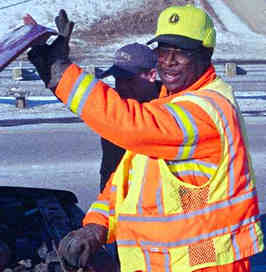 |
|
Highway Helper Kevin
Tucker gives this stalled vehicle a look under the hood. Photo by Teresa
Callies
|
Highway Helper: serving a vital need
Since 1987, Highway
Helpers driving fluorescent green trucks have patrolled selected stretches
of Twin Cities area freeways to assist stalled motorists during peak traffic
hours and to help with minor accidents.
At that time, Commissioner Len Levine "almost had a war on congestion,"
according to Mike Sobolewski, Metro Division planner, who served as Mn/DOT’s
public affairs director in the late 1980s. "Besides Highway Helper, he
launched accident investigation sites and call boxes, among other initiatives,"
he said.
Call boxes and accident investigation sites never "took," but Highway
Helper did. These days, 16 Highway Helpers patrol 170 miles of freeway from
5:30 a.m. to 7:30 p.m. weekdays, in addition to some weekend coverage.
"We help over 13,000 motorists each year," said Sue Groth, program
coordinator, Traffic Management Center. "We’ve received over 3,500 comment
cards over the years, and 97 percent of the people who’ve used the service rate
it as excellent."
The program is also popular among those who’ve never seen a Highway Helper
pull up behind their vehicle.
"Public support for the program has been outstanding," Groth said.
"It’s been part of the Metro perception tracking survey since 1996, and
it’s come out as one of the public’s top-rated traffic management initiatives.
Seventy-six percent of the public are aware of the program; 81 percent of these
people think that it’s a good use of tax dollars."
Vehicle stalls make up about 85 percent of the incidents that Highway Helpers
handle, and Highway Helper Dave Steffer expressed sympathy for the people in
that predicament.
"They’re in an uncomfortable and dangerous situation, and they are so
reassured to see us," Steffer said. "I just got done giving a guy
some gas —brand new car, stalled on the Mississippi River Bridge. Giving him
gas was such a small thing, but he was really appreciative."
That appreciation shows up in letters, phone calls, e-mail, and comment cards.
One writer called the Highway Helpers "the angels of the roadway,"
Groth said. That sentiment takes on special meaning in bad weather.
"Last Friday night, when the bridges were iced over, there were several
accidents," Steffer said. "We were out there with our vehicles and
lights and message signs directing traffic away from the accidents and using
the message signs to warn them that it was icy and they should go slowly."
Their quick response time—in less than 10 minutes about 58 percent of the time,
according to response cards—sometimes means providing services other than gasoline
and tire changes.
"We’re often the first ones on the scene of an accident," Steffer
said, "and we’re all trained as first responders." As first responders,
they provide first aid to accident victims until ambulances arrive. They also
help the State Patrol to direct traffic, thus reducing the potential for more
accidents.
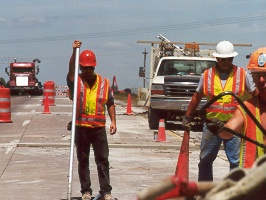 |
|
The work zone safety
campaign evolved to ask drivers to use care in situations such as these:
several road workers concentrating on their job while a truck approaches
from behind. Photo by David Gonzalez
|
Work zone safety: preventing and protecting
Safety drives another outreach program: work zone safety. The work zone safety
campaign began in the mid-1980s and focuses on preventing snowplow collisions
and traffic accidents in construction work zones.
"Work zone safety was something we could do for our workers," Sobolewski,
said. "We were concerned about the snowplow season coming up, and the highway
construction season as well."
Today’s work zone messages include drivers and passengers of vehicles passing
through work zones.
"Drivers and passengers are at the greatest risk; 95 percent of all injuries
and fatalities occur to them," said Mary Meinert, who coordinates today’s
statewide campaign. "Nonetheless, drivers are not concerned with getting
themselves hurt," she added, "they are more concerned about hurting
or killing one of our workers."
Mn/DOT reinforces that concern with safety ads on billboards, television and
radio, as well as in newspapers. Fair and conference booths also drive this
message home, she said, as do the yearly Minnesota Gophers football "Safety
Game" and a statewide speakers bureau.
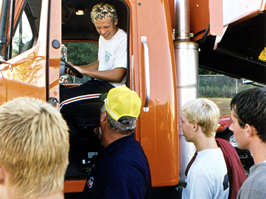 |
|
Kids of all ages enjoy
sitting in the cab of a snowplow. That's partly why this speakers bureau
volunteer (in the yellow hat) brought a snowplow to this class. Photo
by Kevin Walker
|
Speakers’ bureau: getting the message early
"The large majority of speakers bureau presentations are to high school
drivers education classes," said Bill Servatius, speakers
bureau coordinator and transportation program supervisor, Construction Office.
Speakers talk about snowplow safety and work zone safety.
"Historically, there’ve been speakers bureaus before in the districts
and divisions over the years," Servatius said, "but this particular
format was formalized in Metro in 1995 and went statewide in 1997." Trainers
from Metro Division and Central Office partnered to develop a formal curriculum,
with slides, overheads and training for 100 Mn/DOT volunteers statewide.
So far, volunteers have reached about 12,000 people in three years, with a
popularity that impressed Servatius.
"Evaluations are off the map," he said. "On a level of 0-5,
we consistently rate about 4.8, and we usually consider a class to be a success
if we get 4.0."
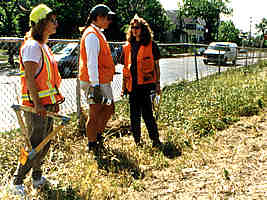 |
|
Left to right: Patti
Strohmayer, Eileen Jordahl and Liz Walton help community volunteers on
the Bryn Mawr landscaping project. Photo by Kevin Walker
|
Improving the landscape together
Two other programs display visible results that people can quite literally
see along state highways: the 10-year-old Community
Landscape Partnership Program (now in Technical Support’s Corridor Development
Unit), and the 12-year-old Adopt-A-Highway campaign.
The two programs have much in common: public involvement, community pride,
attractive roadsides and cost-effectiveness. They work, however, with different
groups by different methods. The low-key landscape partnership program works
with communities that apply for assistance; the once-high-profile Adopt-A-Highway
program works with groups of individuals who provide a service.
The landscape partnership funnels money to local governments and community
groups to enhance the look of roads leading into or passing through their communities.
"The program is a cost reimbursement program," said Todd Carroll,
program coordinator. "Communities sign a cooperative agreement, hire vendors
and supply people to plant and maintain the project. We supply the money and
the plantings; sometimes we do the design, sometimes they do the design."
When local governments and community groups handle the money, "they can
use vendors the state can’t use, and can funnel money to local vendors,"
Carroll said. "That can generate more local buy-in and community pride."
Carroll said that about 20-25 communities a year do landscape plantings under
this program. The unit’s increasing workload might reduce that number, Carroll
said.
Detroit Lakes, Hastings, and Minneapolis neighborhoods Bryn Mawr and Stevens
Square are among the more than 160 communities
that have used the program.
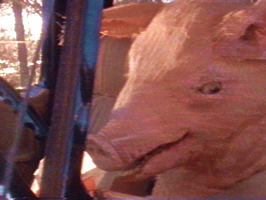 |
|
This pig "starred"
in a highly effective 1990 TV commercial that helped launch the Adopt-a-Highway
program. Still photo from TV video
|
Adopt-A-Highway: don’t waste our state
The Adopt-A-Highway program
arrived in Minnesota on May 19, 1990, with a huge splash, including ceremonies,
news conferences, talk shows and television ads.
"Former Gov. Rudy Perpich was very keen on how things looked," explained
Jan Ekern, Maintenance Office partnerships coordinator and the first Adopt-A-Highway
coordinator, "and Texas had an adopt-a-highway anti-litter campaign called
‘Don’t Mess With Texas.’
"Perpich went down to Texas," she continued, "to talk with Lady
Bird Johnson, the former first lady, who was heavily involved with the campaign.
He came back so impressed that it really became one of his personal passions.
Our then-Commissioner Len Levine was 150 percent behind it and allocated $250,000
for preliminary research and a kick-off."
Before trying to sell Minnesotans on actually going out on roads to pick litter,
Ekern launched "a promotional campaign to tell Minnesotans, ‘Guess what?
We’ve got a litter problem.'"
She added: "We had no clue about what to expect, but we had an overwhelmingly
positive response. We had over 800 media interviews that first year and probably
the fastest start-up of any adopt-a-highway program."
Adopt-a-Highway grew so quickly that it strained district budgets and the Mn/DOT
sign shop as well. That’s because Mn/DOT recognized each volunteer group by
posting a sign—made by the sign shop and paid for by the districts.
"Minnesotans had a passion for the project," Ekern said, "and
it gave Mn/DOT, the governor and the commissioner a great deal of good will."
Mn/DOT’s current Adopt-a-Highway coordinator, Deb Fick, administers a program
that’s less visible locally but is so well-known internationally that Mn/DOT
will host next year’s international Adopt-A-Highway convention. Today’s program,
however, still delivers results.
"We figure we’ve got about 4,800 groups involved, or about 50,000-55,000
Minnesotans," Fick said. "All of the desirable segments are adopted
out and many districts have waiting lists. We still have some less popular segments,
though, that need sponsors."
Fick, recently appointed to the national Adopt-A-Highway board, said that the
program "is a very, very safe program. We’ve had no fatalities or injuries
since the program began. That’s 12 years, 50,000-55,000 people, picking litter
three times a year."
Community outreach: it’s everywhere
These are just a sample of the community outreach initiatives Mn/DOT supports.
The "give back to the community" ethic, however, runs so strongly
throughout the organization that virtually every area can point to significant
community contributions. Some of these include:
-
Redesigning the public hearing process to make it more accessible;
-
Reaching out to non-traditional stakeholders and to communities with people
of color;
-
Using traveler information methods to help ease traffic congestion;
-
Conducting an information campaign that has made Mn/DOT projects part of
the public dialogue;
-
Developing curriculums and programs that help teachers provide enriched
learning experiences to students of all ages; and
-
Fostering tutoring, educational and employment programs that encourage
students to enjoy technology and math—and, potentially, transportation technology
careers with Mn/DOT.
These are just the tip of the iceberg of Mn/DOT-sponsored initiatives. They’re
all part of Mn/DOT’s customer service—and what Minnesotans value.
|



